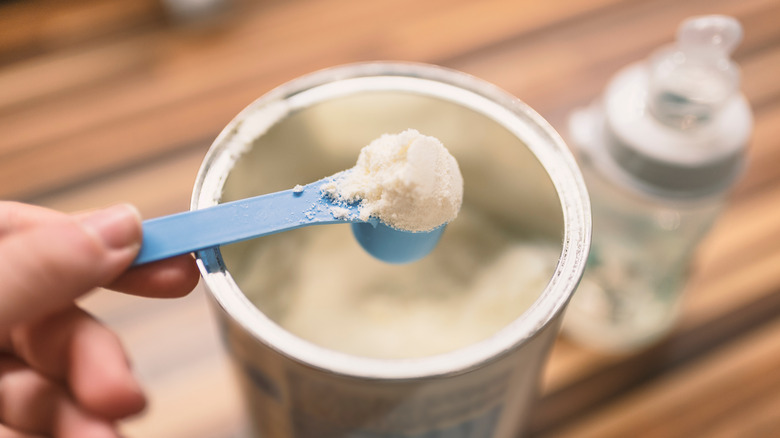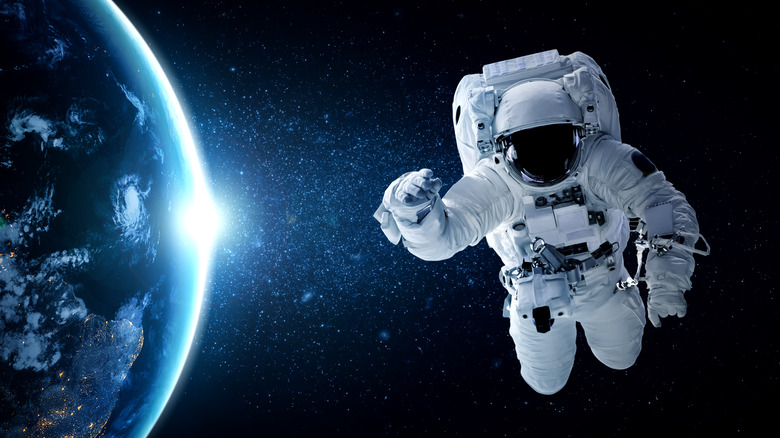NASA Research Actually Led To The Creation Of Enhanced Baby Formula
In the spring of 2022, parents in the United States were made acutely aware of how important baby formula is. The product that could always be expected to be in abundance on store shelves suddenly became scarce, creating a baby formula shortage. As Bloomberg explains, the shortage was the result of ongoing supply-chain and labor force issues brought about by the COVID-19 pandemic, as well as a recall of product made at a Michigan factory. The shortage forced American parents without access to breast milk to go to great lengths to secure the product, including via crowdsourcing (via Jewish Press).
Baby formula came about in the 19th century, according to The Journal of Perinatal Education (posted at the National Library of Medicine), in response to advancements in food technology, as well as economic shifts that resulted in more women working and, thus, unable to breastfeed their babies. And though no infants have been born in or even gestated in space, to say nothing of having ever been taken up there, per NASA, it was a breakthrough in the space program that led to an increase in the nutritional value of baby formula.
Baby formula's complicated history
For tens of thousands of years, the only way to get nourishing food into the mouth of a newborn was via its own mother's milk, through breastfeeding. However, not every mother can breastfeed, and until a good alternative came along, the only options were for the baby to die of malnutrition, or for another woman to breastfeed on the mother's behalf – acting as a wet nurse (per Romper).
This worked reasonably well for millennia, according to The Journal of Perinatal Education. However, in the 19th century, when economic shifts in Europe meant that poorer women were going to work instead of staying home (and nursing their babies), the problem of infant malnutrition became immediate. At the same time, advancements in food storage technology were extending the shelf life of perishable foods, including dairy products. In 1860, according to Contemporary Pediatrics, German chemist Justus von Leibig developed the first commercial baby food.
Baby formula occupies a controversial space in the American nutritional landscape. For some families it's a necessity, despite the fact that its use has been associated with several common childhood illnesses, including diabetes mellitus and childhood obesity, according to The Journal of Perinatal Education. And while the pediatrics community agrees that breast milk is best (per Johns Hopkins Medicine), it's not a possibility for many families, and some mothers (per What To Expect) feel like they're guilted and shamed for not breast-feeding.
What does the space program have to do with this?
Regardless of the limitations of baby formula, there's at least one nutrient that's been a part of the recipe for all mass-produced infant formulas in the United States since the 1990s, where previously it had only been available in breast milk. According to NASA, the space agency has been looking at foods and food-adjacent products that can be taken on long space missions — longer than just the few months that astronauts spend up there now. Missions to Mars are going to take years, not months, and sending up shelf-stable food that doesn't weigh much but is still packed with nutrition is a top priority. A team of researchers landed on a source of DHA, an omega-3 fatty acid, naturally found in the body, and began looking at it as a nutrient on long-term space flights.
However, according to Gerber, that nutrient is also beneficial to infants, both in utero and when they are breastfeeding. And since 1994, the nutrient has been added to commercial, mass-produced baby formulas. Specifically, it's in 90% of them, according to NASA, and it's helping babies "develop healthy brains, eyes, and hearts."


